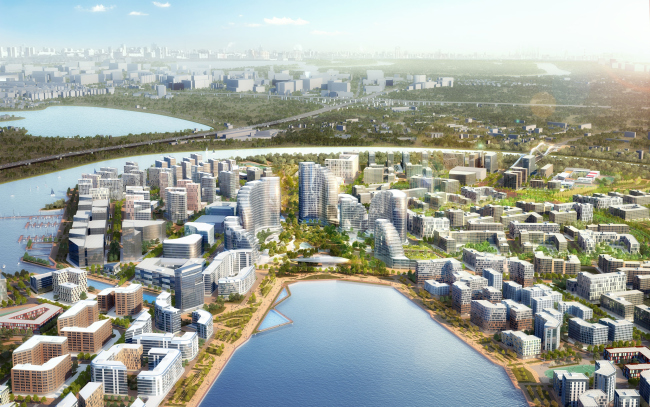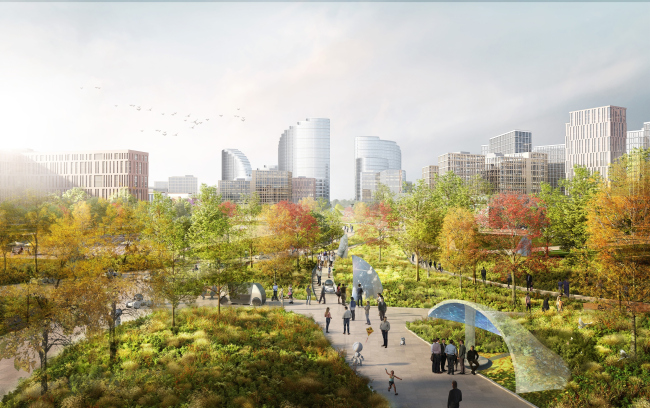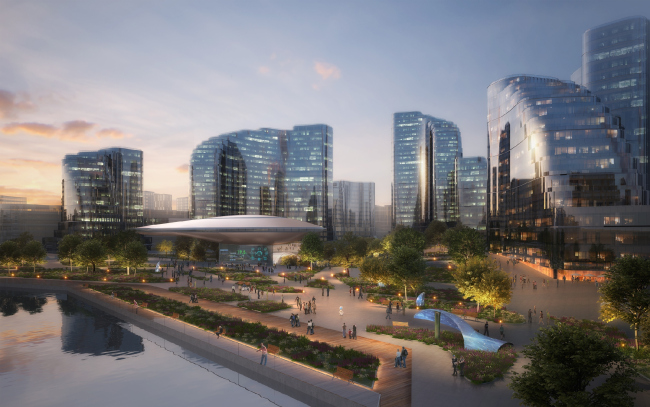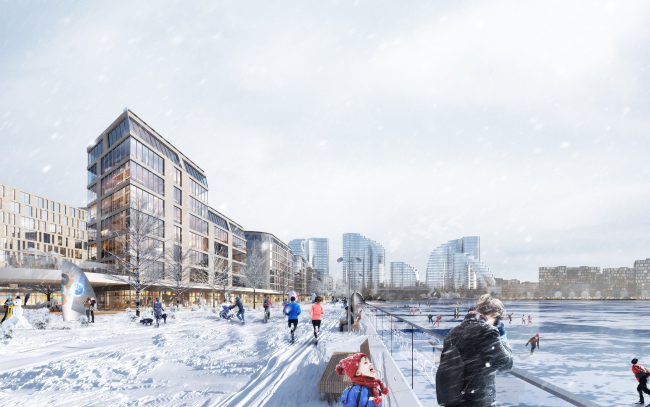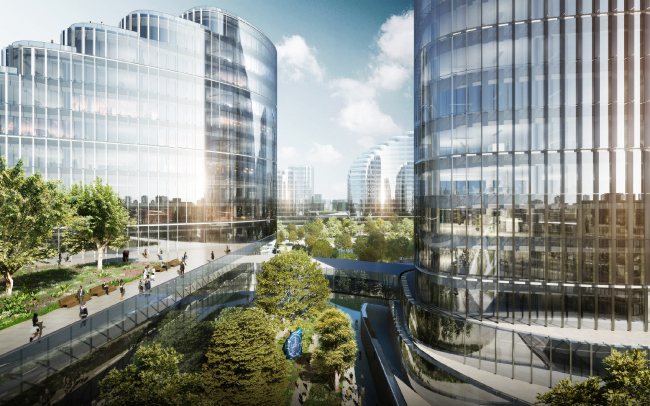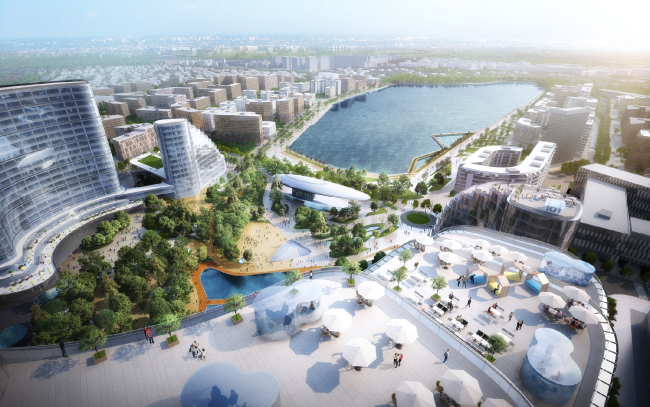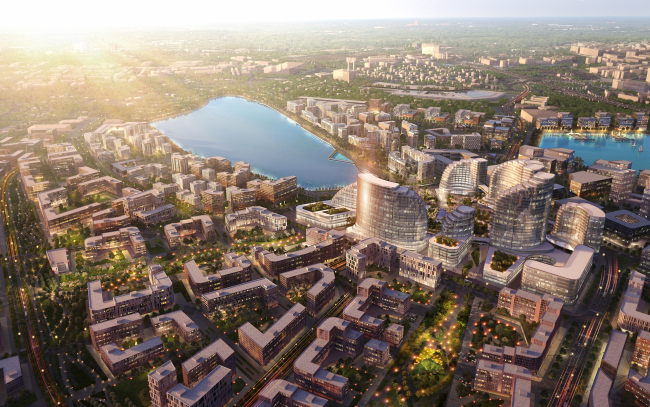|
Published on Archi.ru (https://archi.ru) |
|
| 13.09.2019 | |
|
A Futuristic Network |
|
|
Julia Tarabarina |
|
| Studio: | |
| Nikken Sekkei | |
| UNK | |
|
A highway bridge as a place for recreation and contemplation; a network of pedestrian arteries and capillaries full of greenery, also meant for locomotion and communication, and a network of “smart devices” meant to help people – all of this is combined in the project called “Linked City”. Rublevo-Arkhangelskoe, architectural and town planning concept. The competition winning projectCopyright: © Nikken Sekkei / provided by AO “Rublevo-Arkhangelskoe”Developed by a consortium of Nikken Sekkei, UNK project, D&S, and JLL, this project became one of the three finalists of the competition for the architectural and town-planning concept developed for a large piece of land in the area of Rublevo-Arkhangelskoe, lying just beyond the Moscow Ring Road, and officially proclaimed to be a part of Moscow in 2012 (more information about the competition and the land site is available here). Working with the pre-approved site plan, all of the contestants were supposed to propose solutions that would uncover the Smart City concept, essential to this project, demonstrating the contestant’s idea of this “smart city” in as much detail as possible, and showing possibilities for its implementation in real life. “Our team proposed to create what we called a “linked city”, in which the architectural environment is closely connected to the natural one, and which incorporates smart technologies of the “city of the future” – share the architects of Nikken Sekkei – Our project attaches particular importance to fostering creativity and manifesting the individuality of every resident of this area; the project is meant to create a public space that would be conducive to people communicating with one another and with the city”. “What was slightly peculiar in this competition was the fact that, among other things, you had to submit the economic model – says the leader of the UNK, Yuliy Borisov – Together with our colleagues from Nikken Sekkei, we invited the top experts in this area for economic calculations both in terms of the likeliest property sales, and the economics of the construction process. Because here is the thing – today people buy real property or change their place of residence not because they’ve got nowhere to live – the architect continues – but because they want to improve the quality of life for themselves and, more importantly, for their children. And they are looking to improve their residential conditions not only on the down-to-earth level, like increasing the number of square meters or buying an apartment closer to a metro station, but they are also looking to improve their living environment in terms of a combination of factors: a school nearby, places to work at, and the environmental situation. Using a whole range of tools and techniques, we tried to increase as much as possible the attractiveness of this housing property on the whole, and also in terms of its probable aftermarket value”.  “Rublevo-Arkhangelskoe” housing complex, master layoutCopyright: © Nikken Sekkei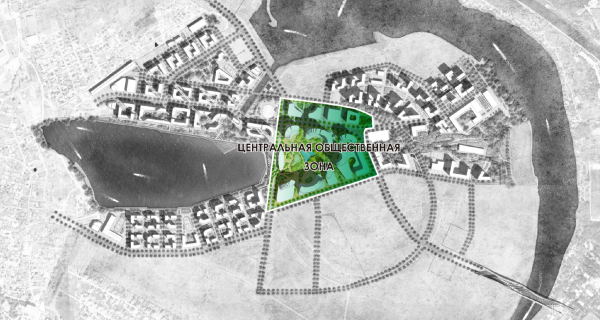 None None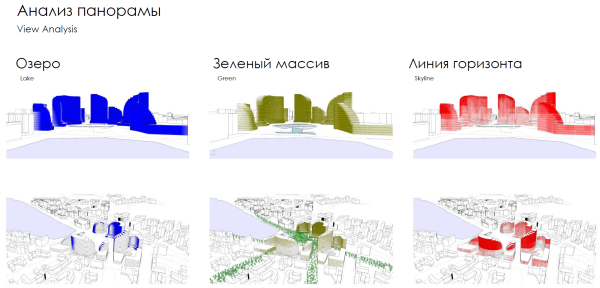 NoneThus, the joint Russian-Japanese project is all about new technologies, a look at the public territories as “real-life” internet, and the abundance of vegetation. A City of Smart Technologies Some of the technological novelties of our time are rather predictable and lie in the area of the rules of an environmentally responsible city. Waste sorting, purification and recycling of technical water, using the solar energy and the energy of wind, warmth storage and using it for heating the houses. The architects are augmenting this list: specifically, for the energy supplies of the office buildings, they are proposing a trigeneration complex that produces not only heat and electricity but cold as well. In addition to the joint power network, the office buildings are united by an underground parking garage lying underneath the entire construction blueprint. For the office towers, the authors proposed double glass façades: in the summertime, cool air will circulate between the two layers of glass; while warm in spring and in fall, in the wintertime this air barrier gets heated up from the heating elements on each floor. The system is complemented by vertical lamella ribs that dissect the façades in order to protect them from direct sunlight – the shape of the lamellas and their presence being flexibly dependent upon the expected amount of light: in those places that are likely to be less exposed to sunlight, they gradually become smaller and then disappear altogether. The architects are proposing to equip the apartments with heated glass units and inbuilt floor radiators, replaced, in the less expensive versions, with low-rise radiators 30 centimeters tall, instead of the usual half meter. Rublevo-Arkhangelskoe, architectural and town planning concept. The competition winning projectCopyright: © Nikken Sekkei / provided by AO “Rublevo-Arkhangelskoe”Meanwhile, the architectural techniques per se are also not without some “fine tuning” innovations. For example, the structure of the office buildings also allows for a possibility of flexible change. And the window apertures in the residential buildings grow in size from the low floors up to the top: down below, the smaller windows ensure privacy, while the larger windows of the higher floors command fine views of the surrounding scenery. In the joint project by Nikken Sekkei and UNK, yet another innovation for Russia, a country where people tend to rather buy housing property than rent it, is the relatively high percentage of apartments meant for rent. Still another type of innovation refers to organization and planning: the architects are proposing to build community centers, from playgrounds to marketplaces and museums, in a few stages. Initially, a few simple temporary facilities will do, which with time will be replaced with constant ones, more interesting from the architectural standpoint. What is important is the fact that the construction process, by all estimates, is going to stretch until 2045. However, the architects do not just limit themselves to a sum total of technical novelties, fine-tuning, and efficiency proposals, trying to emphasize the futuristic character of this area, especially in its central “office” part. Here, the main plaza gets a small building – a streamlined pavilion standing on a stout leg, made of glass, with a sharp nose, and looking like some space age airport control tower. It is called Smart Linked Center and really takes on the functions of a coordination center for the Smart Devices, scattered all over the area, showing time, allowing you to recharge your smartphone, spreading the Wi-Fi signals, and letting the people feel some benign presence of technology that is always ready to come to their rescue. This is one of the widespread motifs in science fiction: some centers, scattered all over the planet, allowing people to feel that they are near civilization even in the deep forest. In this specific case – on the whole territory of the new city. The architects have called this network “smart infrastructure”. It looks like the symbol of Smart City, a conceptual point of sorts, asserting its futuristic essence. On the other hand, these pavilions are, of course, not just the symbol of a smart city but an actual container for its state-of-the-art technologies. Rublevo-Arkhangelskoe, architectural and town planning concept. The competition winning projectCopyright: © Nikken SekkeiEnvironment It would have been wrong, of course, to work with a 461-hectare chunk of land and forget to fill it with green zones. The architects unite the concept of greenery, which is to be seen everywhere around here, including the yards of the residential houses with specially approved giant trees, with the theme of being “linked”, the theme of an information network, echoed by the network of human communications, a space for walking and interacting. They are proposing three “parkway corridors” – wide boulevards that will link the central area with the river banks, tying them in with the green waterfronts and lakeside trails, as well as with the smaller-scale roads that run around and inside the city blocks, united, as the architects put it, into a “Nature Passage”. All of these things put together, the authors explain, form a single pedestrian network with hubs that allow people, particularly the elderly and the children, to safely walk around. Rublevo-Arkhangelskoe, architectural and town planning concept. The competition winning projectCopyright: © Nikken Sekkei / provided by AO “Rublevo-Arkhangelskoe”Destination Bridge (Russian: “Most Prednaznacheniya”) Still, there is a difference between the two languages, at least intonation-wise. In Russian, this name sounds truly solemn, even slightly pompous. In English, this name sounds more exact and more down-to-earth: this is a bridge that not only serves as a part of the communication framework but can itself be regarded as a destination; meaning, it is expected that one will be able to come here just for the fun of it, and not just moving from point A to point B. The bridge over the Moskva River in the southeastern part of the territory, necessary for achieving a better connection with the city and facing the line of the Rublev Highway, is important as a part of the automotive traffic, but the architects are also turning it into a space where people can go for walks. Walking on the opposite bank of the river, between the old villa community Rublevsky and the restricted-access area of the Vodokanal Station is not yet possible. And for this reason, the architects interpret the bridge itself as a place for recreation, which also commands fine river views. In addition, the bridge is a beautiful thing to look at, and our country still does not have a lot of truly beautiful bridges, although around the world it is the bridges that show the best example of the aesthetics of engineering thought. Here, the arches of the two-span cable-braced bridge that covers the river about 100 meters wide, are made of piped structures that will contain pedestrian and bicycle trails. When walking, people will be able to go out on the balconies that alternate with the protrusions of the adaptive mass dampers necessary for ensuring the construction’s stability. The location of the balconies is defined by the best vantage points. The one that commands the finest views is turned into a lawn that literally hangs over the river. Glittering Glass and Parametric The bridge is an accent on the border of the territory, part of its representation to the city. The main element of the perception scenario, however, is situated in the center of the town and naturally has to do with the transportation hub. Here, alighting from the metro, we, very much like in La Défense de Paris (or in the Moscow City, for that matter), can look up to admire the towering glass-and-concrete giant. This effect is pre-calculated: it is clear at once that we are in the center of innovative business. Rublevo-Arkhangelskoe, architectural and town planning concept. The competition winning projectCopyright: © Nikken SekkeiThe towers, which are indeed the highest buildings around here, look like peculiar sails made of glass, and are present at all the panoramas of the complex, just like the Moscow City is present in all panoramas of the nation’s capital. The difference is that these towers stand slightly farther away from each other, and they are not as tall – the tallest high-profile one is 130 meters high. The outlines of the buildings look as though they had been molded on a sculptural principle, yet in reality they were defined parametrically – as a result of analyzing the prevailing and dominant winds. The volumes are almost literally “washed” by the streams of wind because they were designed to brush it off – hence the streamlined shapes. Rublevo-Arkhangelskoe, architectural and town planning concept. The competition winning projectCopyright: © Nikken SekkeiThe ledgy silhouettes, reminiscent of Habitat, helped to place on the operated roofs a lot of terraces commanding fine lake views, with cafés and meeting points – these are supposed to serve both for recreation and for business communication in the vein of “let’s discuss this over a cup of coffee up on the roof”. Rublevo-Arkhangelskoe, architectural and town planning concept. The competition winning projectCopyright: © Nikken SekkeiTypes of Housing Still, the residential stock occupies more than two thirds of the multifunctional complex (or should we call it a town, after all?) The façades of the residential houses, unlike the office buildings, are chiefly rectangular, with a prominent grid of windows, often grouped in twos and threes, of mostly vertical proportions. Rublevo-Arkhangelskoe, architectural and town planning concept. The competition winning projectCopyright: © Nikken Sekkei / provided by AO “Rublevo-Arkhangelskoe”The architects subdivide the residential houses into a few districts. The eastern one, next to the metro station, is interpreted as the place for the people who actually work downtown, because commuting to Moscow will be easy here. The exit from the metro station is designed as a large heated gallery, mostly transparent, which would allow the people to get to their homes, or stores, or other public places without having to go outside. The district situated to the north of the lake is meant for the up-and-coming millennials; it includes premium-class housing with windows reaching to the floor, and a lakeside promenade nearby. This “young and modern” district contains more glass, even though warm galleries running alongside the buildings are also provided. The south district is treated as a place for families and the elderly – its architecture contains much more “traditional” stone in it, the yards are more private, and, in addition, there are more schools here, which are located close to people’s homes – so that grannies could takes their grandchildren to school easily. *** Designing cities of the future is a genre that architects and urbanists have been exploring for at least five centuries. As a rule, it is linked to the hopes for something glorious, dynamic, at the same time comfortable, and, of course, smart. Smarter than the way it used to be, and the way it is now. The very genre itself is all about people’s hope for a new life, and belief in a better tomorrow. Possibly, this project will indeed be capable of raising a large chunk of Moscow land and turning it into an economic wonder. Let’s wait and see. This particular project is only a part of a bigger process and futuristic meditation that inevitably accompanies it. |
|
